United States invasion of Grenada
The United States invasion of Grenada began at dawn on 25 October 1983. The U.S. and a coalition of six Caribbean nations invaded the island nation of Grenada, 100 miles (160 km) north of Venezuela. Codenamed Operation Urgent Fury by the invaders, it resulted in military occupation within a few days.[10] It was triggered by the strife within the People's Revolutionary Government which resulted in the house arrest and execution of the previous leader and second Prime Minister of Grenada Maurice Bishop, and the establishment of the Revolutionary Military Council with Hudson Austin as Chairman. The invasion resulted in the appointment of an interim government, followed by democratic elections in 1984. The country has remained a democratic nation since then.
| Operation Urgent Fury | |||||||
|---|---|---|---|---|---|---|---|
| Part of the Cold War | |||||||
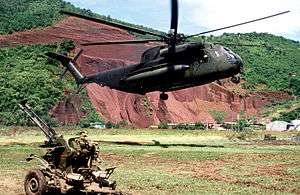 A Marine Corps Sikorsky CH-53 Sea Stallion helicopter hovers above the ground near an abandoned Soviet ZU-23-2 anti-aircraft weapon during the invasion of Grenada in 1983 | |||||||
| |||||||
| Belligerents | |||||||
|
| |||||||
| Commanders and leaders | |||||||
| |||||||
| Strength | |||||||
United States:
353 |
Grenada:
784 (including 636 construction workers)[3]:6, 26, 62 Soviet Union: 49 North Korea: 24[2] East Germany: 16 Bulgaria: 14 Libya: 3–4 | ||||||
| Casualties and losses | |||||||
|
United States: 19 killed[4] 116 wounded[3]:6, 62 36 injured[5] 9 helicopters destroyed[5][6] |
Grenada:
| ||||||
| 24–67 civilians killed (18 of them when a mental hospital was accidentally bombed by the U.S. Air Force)[5] | |||||||
Grenada had gained independence from the United Kingdom in 1974. The Communist New Jewel Movement seized power in a coup in 1979 under Maurice Bishop, suspending the constitution and detaining several political prisoners. In September 1983, an internal power struggle began over Bishop's leadership performance.[11] Bishop was pressured at a party meeting to share power with Deputy Prime Minister Bernard Coard. Bishop initially agreed, but later balked. He was put under house arrest by his own party's Central Committee until he relented. When his secret detention became widely known, Bishop was freed by an aroused crowd of his supporters. A confrontation then ensued at military headquarters between Grenadian soldiers loyal to Coard and civilians supporting Bishop. Shooting started under still-disputed circumstances. At least 19 soldiers and civilians were killed on 19 October 1983 including Bishop, his partner Jacqueline Creft, two other cabinet ministers and two union leaders.
The Reagan administration in the U.S. launched a military intervention following receipt of a formal appeal for help from the Organisation of Eastern Caribbean States. In addition, Grenada's Governor General Paul Scoon secretly signaled he would also support outside intervention, but he put off signing a letter of invitation until 26 October.[12] Reagan also acted due to "concerns over the 600 U.S. medical students on the island" and fears of a repeat of the Iran hostage crisis.
The invasion began on the morning of 25 October 1983, just two days after the bombing of the U.S. Marine barracks in Beirut. The invading force consisted of the Army's rapid deployment force, Marines, Army Delta Force, Navy SEALs, and ancillary forces totaling 7,600 troops, together with Jamaican forces and troops of the Regional Security System (RSS).[13] The force defeated Grenadian resistance after a low-altitude airborne assault by Rangers and the 82nd Airborne on Point Salines Airport at the south end of the island, and a Marine helicopter and amphibious landing on the north end at Pearls Airport. Austin's military government was deposed and replaced, with Scoon as Governor-General, by an interim advisory council until the 1984 elections.
The invasion was criticized by many countries, including Canada. British Prime Minister Margaret Thatcher privately disapproved of the mission and the lack of notice that she received, but she publicly supported it.[14] The United Nations General Assembly condemned it as "a flagrant violation of international law" on 2 November 1983 with a vote of 108 to 9.[15] Conversely, there was broad public support in the United States,[16] and the Grenadian population approved of American intervention, appreciating the fact that there had been relatively few civilian casualties, as well as the return to democratic elections in 1984.[17][18]
The date of the invasion is now a national holiday in Grenada called Thanksgiving Day, commemorating the freeing of several political prisoners who were subsequently elected to office. A truth and reconciliation commission was launched in 2000 to re-examine some of the controversies of the era; in particular, the commission made an unsuccessful attempt to find Bishop's body, which had been disposed of at Austin's order and never found. The invasion also highlighted issues with communication and coordination between the different branches of the American military when operating together as a joint force, contributing to investigations and sweeping changes in the form of the Goldwater-Nichols Act and other reorganizations.[19]
Background
.jpg)
Sir Eric Gairy had led Grenada to independence from the United Kingdom in 1974, but his term in office coincided with civil strife in Grenada. He was head of the Grenada United Labour Party and claimed victory in the general election of 1976, but the opposition did not accept the result as legitimate.[20] The civil strife took the form of street violence between Gairy's private army the Mongoose Gang, and gangs organized by the New Jewel Movement (NJM). Maurice Bishop led the NJM in an armed revolution and overthrew the government on 13 March 1979, while Gairy was out of the country, establishing the People's Revolutionary Government.[19]
Airport
The Bishop government began constructing the Point Salines International Airport with the help of Britain, Cuba, Libya, Algeria, and other nations. The British government proposed the airport in 1954 when Grenada was still a British colony. Canadians designed it, the British government underwrote it, and a London firm built it. The American government accused Grenada of constructing facilities to aid a Soviet-Cuban military buildup in the Caribbean based on the 9,000-foot (2,700 m) runway which could accommodate the largest Soviet aircraft, such as the An-12, An-22, and the An-124. Such a facility would enhance the Soviet and Cuban transportation of weapons to Central American insurgents and expand Soviet regional influence. Bishop's government claimed that the airport was built to accommodate commercial aircraft carrying tourists, pointing out that such jets could not land at Pearls Airport on the island's north end (5,200 feet), and that Pearls could not be expanded because its runway abutted a mountain at one end and the ocean at the other.[21]

In 1983, Representative Ron Dellums (D, California) traveled to Grenada on a fact-finding mission, having been invited by the country's prime minister. He described his findings before Congress:
Based on my personal observations, discussion, and analysis of the new international airport under construction in Grenada, it is my conclusion that this project is specifically now and has always been for the purpose of economic development and is not for military use…. It is my thought that it is absurd, patronizing, and totally unwarranted for the United States government to charge that this airport poses a military threat to the United States' national security.[22]
In March 1983, President Reagan began issuing warnings about the threat posed to the United States and the Caribbean by the Soviet-Cuban militarization of the Caribbean, evident from the excessively long airplane runway being built and intelligence indicating increased Soviet interest in the island. He said that the runway and the numerous fuel storage tanks were unnecessary for commercial flights, and that evidence indicated that the airport was to become a Cuban-Soviet forward military airbase.[23]
On 29 May 2009, the Grenadian government changed the name of Point Salines International Airport to Maurice Bishop International Airport.[24][25]
October 1983
On 16 October 1983, Deputy Prime Minister Bernard Coard seized power and placed Bishop under house arrest. There were mass protests against this which led to Bishop escaping detention and reasserting his authority as the head of the government. He was eventually captured and murdered by a firing squad of soldiers, along with his partner and several government officials and union leaders who were loyal to him. The army under Hudson Austin then stepped in and formed a military council to rule the country, and they placed Governor-General Paul Scoon under house arrest. The army announced a four-day total curfew where anyone seen on the streets would be summarily executed.
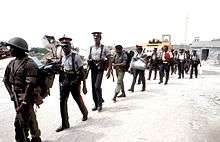
The Organization of Eastern Caribbean States (OECS), Barbados, and Jamaica all appealed to the United States for assistance.[3] Scoon had requested the invasion through secret diplomatic channels, but it was not made public for his safety.[26] He was well within his rights to take this action under the reserve powers vested in the Crown.[27] On Saturday 22 October 1983, the Deputy High Commissioner in Bridgetown, Barbados visited Grenada and reported that Scoon was well and "did not request military intervention, either directly or indirectly",[28] but in his 2003 autobiography, Survival for Service,[29][30] Scoon maintains he asked the visiting British diplomat to pass along "an oral request" for outside military intervention at this meeting.
On 25 October, the combined forces of the United States and the Regional Security System (RSS) based in Barbados invaded Grenada in an operation code named Operation Urgent Fury. America stated that this was done at the request of Barbados' Prime Minister Tom Adams and Dominica's Prime Minister Eugenia Charles. The invasion was highly criticized by the governments in Canada, Trinidad and Tobago, and the United Kingdom. The United Nations General Assembly condemned it as "a flagrant violation of international law"[31] by a vote of 108 to 9, with 27 abstentions.[32]
First day of the invasion
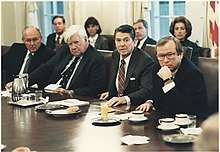
H-hour for the invasion was set for 0500 on 25 October 1983. U.S. commandos deployed for Grenada by helicopter from Grantley Adams International Airport on Barbados before daybreak.[33][34] Nearly simultaneously, American paratroopers arrived directly by transport aircraft from bases in the eastern United States and U.S. Marines were airlifted to the island from the USS Guam offshore. It was the first major operation conducted by American military since the Vietnam War.[35] Vice Admiral Joseph Metcalf, III, Commander of the Second Fleet, was the overall commander of American forces, designated Joint Task Force 120, which included elements of each military service and multiple special operations units. Fighting continued for several days and the total number of American troops reached some 7,000 along with 300 troops from the Organization of American States (OAS), commanded by Brigadier Rudyard Lewis of Barbados. The invading forces encountered about 1,500 Grenadian soldiers and about 700 armed Cuban nationals manning defensive positions. The People's Revolutionary Army possessed eight BTR-60PB armored personnel carriers and two BRDM-2 scout cars that they had received from the Soviet Union in February 1981, but no tanks.[36][37] Their arsenal also included twelve ZU-23 anti-aircraft guns, DShK heavy machine guns, and a limited number of M37 82mm mortars and RPG-7 launchers.
The main objectives on the first day were for the 75th Ranger Regiment to capture the Point Salines International Airport in order for the 82nd Airborne Division to land reinforcements on the island; the 8th Marine Regiment to capture Pearls Airport; and other forces to rescue the American students at the True Blue Campus of St. George's University. In addition, a number of special operations missions were undertaken by Army Delta Force operatives and Navy SEALs to obtain intelligence and secure key individuals and equipment. Many of these missions were plagued by inadequate intelligence, planning, and accurate maps of any kind, and the American forces mostly relied upon tourist maps.
Cuban forces in Grenada
The Cuban military presence in Grenada was more complex than initially thought.[19][38] The Cubans blurred the line between civilians and military personnel, as they did in Angola, Ethiopia, and other nations. For example, Fidel Castro often described Cuban construction crews deployed overseas as "workers and soldiers at the same time," the dual nature of their role being consistent with Havana's "citizen soldier" tradition.[38] At the time of the invasion, there were an estimated 784 Cuban nationals on the island.[39] At least 636 Cubans were formally listed as construction workers, another 64 as military personnel, and 18 as dependents. The remainder were either medical staff or teachers.[39] Colonel Pedro Tortoló Comas was the highest-ranking Cuban military official in Grenada in 1983, and he later stated that he issued weapons and ammunition to many of the construction workers for the purpose of self-defense.[39] Bob Woodward wrote in Veil that captured "military advisors" from socialist countries were actually accredited diplomats and their dependents. He claimed that none of them took any actual part in the fighting.[40] Other historians have asserted that most of the supposed civil technicians on Grenada were Cuban special forces and combat engineers.[41] Cuban nationals were expressly forbidden to surrender to American forces.[39]
Navy SEAL reconnaissance missions
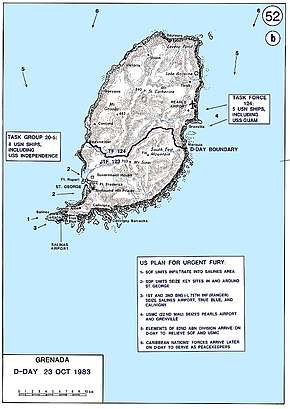
U.S. Special Operations Forces were deployed to Grenada beginning on 23 October, before 25 October invasion. Navy SEALs from SEAL Team Six with Air Force combat controllers were airdropped at sea to perform a reconnaissance mission on Point Salines. Four SEALs were lost at sea, and their bodies were never recovered causing most people to suspect that the four SEALs had drowned.[19] The four SEALs that were believed to have drowned were Machinist Mate 1st Class Kenneth J. Butcher, Quartermaster 1st Class Kevin E. Lundberg, Hull Technician 1st Class Stephen L. Morris, and Senior Chief Engineman Robert R. Schamberger. In an interview conducted by Bill Salisbury and published on October 4, 1990, Kenneth Butcher's widow claimed that she had gone to Grenada hoping that her husband had survived. She said, "There was this fisherman who said he saw four guys in wetsuits come out of the water, and then two days later he saw four bodies being thrown into the water. So we would like to think they made it, ’cause there was a boat smashed up on the beach. We would like to think the four of them got in that boat, made it to shore, got someplace, and were captured. And they’re, you know, gonna come back." [42] The survivors continued their mission, but their boats flooded while evading a patrol boat, causing the mission to be aborted. Another SEAL mission was unsuccessful on 24 October also due to harsh weather, resulting in little intelligence being gathered in advance of the impending intervention.
Air assault on Point Salines
A and B companies of the 1st Battalion of the 75th Ranger Regiment embarked on C-130s at Hunter Army Airfield at midnight on 24 October to perform an air assault landing on Point Salines International Airport, intending to land at the airport and then disembark. But the Rangers had to switch abruptly to a parachute landing when they learned mid-flight that the runway was obstructed. The air drop began at 05:30 on 25 October in the face of moderate resistance from ZU-23 anti-aircraft guns and several BTR-60 APCs, which were knocked out by M67 recoilless rifle fire. AC-130 gunships provided support for the landing. Cuban construction vehicles were commandeered to help clear the airfield, and one was even used to provide mobile cover for the Rangers as they moved to seize the heights surrounding the airfield.[44]
They cleared the airstrip of obstructions by 10 AM, and transport planes were able to land and unload additional reinforcements, including M151 Jeeps and members of the Caribbean Peace Force who were assigned to guard the perimeter and detainees. Starting at 14:00, units began landing at Point Salines from the 82nd Airborne Division under Edward Trobaugh, including battalions of the 325th Infantry Regiment. At 15:30, three BTR-60s of the Grenadian Army Motorized Company counter-attacked, but the Americans repelled them with recoilless rifles and an AC-130.[45]
The Rangers fanned out and secured the surrounding area, including negotiating the surrender of more than 100 Cubans in an aviation hangar. However, a Jeep-mounted Ranger patrol became lost searching for True Blue Campus and was ambushed, with four killed. The Rangers eventually secured True Blue campus and its students, where they found only 140 students and were told that more were at another campus in Grand Anse. In all, the Rangers lost five men on the first day, but succeeded in securing Point Salines and the surrounding area.[44]
Capture of Pearls Airport
A platoon of Navy SEALs from SEAL Team 4 under Lieutenant Mike Walsh approached the beach near Pearls Airport around midnight on 24 October after evading patrol boats and overcoming stormy weather. They found that the beach was lightly defended but unsuitable for an amphibious landing. The 2nd Battalion of the 8th Marine Regiment then landed south of Pearls Airport using CH-46 Sea Knight and CH-53 Sea Stallion helicopters at 05:30 on 25 October; they captured Pearls Airport, encountering only light resistance, including a DShK machine gun which a Marine AH-1 Cobra destroyed.[46]
Raid on Radio Free Grenada
UH-60 Blackhawk helicopters delivered SEAL Team 6 operators in the early morning of 25 October to Radio Free Grenada with the purpose of using the radio station for psychological operations. They captured the station unopposed and destroyed the radio transmitter. However, they were attacked by Grenadian forces in cars and an armored personnel carrier (APC), which forced the lightly armed SEALs to cut a fence and retreat into the ocean as they received fire from the APC. The SEALs swam to the USS Caron.[47] At least two were seriously wounded and bleeding, one with a shoulder injury and the other with a calf injury. Both SEALs were transferred by helicopter to USS Independence.
Raids on Fort Rupert and Richmond Hill Prison
On 25 October, Delta Force and C Company of the 75th Ranger Regiment embarked in MH-60 and MH-6 Little Bird helicopters of Task Force 160 to capture Fort Rupert, where they believed the Revolutionary Council leaders lived, and Richmond Hill Prison, where political prisoners were being held. The raid on Richmond Hill Prison lacked vital intelligence, including the fact that several anti-aircraft guns defended it, and that the prison was on a steep hill without room for a helicopter to land. Anti-aircraft fire wounded passengers and crew and forced one MH-60 helicopter to crash land, causing another helicopter to land next to it to protect the survivors. One pilot was killed, and the Delta Force operators had to be relieved by a Navy Sea King helicopter.[49] The raid on Fort Rupert, however, was successful in capturing several leaders of the People's Revolutionary Government.[45]
Mission to rescue Governor General Scoon
The last major special operation was a mission to rescue Governor General Scoon from his mansion in Saint George, Grenada. The mission departed late at 05:30 on 25 October from Barbados, resulting in the Grenadian forces being already aware of the invasion and they guarded Scoon closely. The SEAL team entered the mansion without opposition, but BTR-60 armored personnel carriers counter-attacked and trapped the SEALs and the governor inside. AC-130 gunships, A-7 Corsair strike planes, and AH-1 Cobra attack helicopters were called in to support the besieged SEALs, but the SEALs remained trapped for the next 24 hours.
At 19:00 on 25 October 250 Marines from G Company of the 22nd Marine Assault Unit landed at Grand Mal Bay equipped with amphibious assault vehicles and four M60 Patton tanks; they relieved the Navy SEALs the following morning, allowing Governor Scoon, his wife, and nine aides to be safely evacuated at 10:00 that day. The Marine tank crews continued advancing in the face of sporadic resistance, knocking out a BRDM-2 armored car.[37] G Company subsequently defeated and overwhelmed the Grenadian defenders at Fort Frederick.[46]
Airstrikes
Navy A-7 Corsairs and Marine AH-1 Cobra attack helicopters made airstrikes against Fort Rupert and Fort Frederick. An A-7 raid on Fort Frederick targeting anti-aircraft guns hit a nearby mental hospital, killing 18 civilians.[3]:62 Two Marine AH-1T Cobras and a UH-60 Blackhawk were shot down in a raid against Fort Frederick, resulting in five casualties.[46]
Second day of the invasion
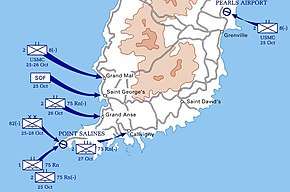
General Trobaugh of the 82nd Airborne Division had two goals on the second day: securing the perimeter around Salines Airport, and rescuing American students held in Grand Anse. The Army lacked undamaged helicopters after the losses on the first day and consequently had to delay the student rescue until they made contact with Marine forces.
Attack on the Cuban compound
Early on the morning of 26 October, Cuban forces ambushed a patrol from the 2nd Battalion of the 325th Infantry Regiment near the village of Calliste. The American patrol suffered six wounded and two killed, including the commander of Company B. Navy airstrikes and an artillery bombardment by 105mm howitzers targeting the main Cuban encampment eventually led to their surrender at 08:30. American forces pushed on to the village of Frequente, where they discovered a Cuban weapons cache reportedly sufficient to equip six battalions. Cuban forces ambushed a reconnaissance platoon who were mounted on gun-jeeps, but the jeeps returned fire, and a nearby infantry unit added mortar fire; the Cubans suffered four casualties with no American losses. Cuban resistance largely ended after these engagements.[44]
Rescue at Grand Anse
On the afternoon of 26 October, Rangers of the 2nd Battalion of the 75th Ranger Regiment mounted Marine CH-46 Sea Knight helicopters to launch an air assault on the Grand Anse campus. The campus police offered light resistance before fleeing, wounding one Ranger, and one of the helicopters crashed on the approach after its blade hit a palm tree. The Rangers evacuated the 233 American students by CH-53 Sea Stallion helicopters, but the students informed them that there was a third campus with Americans at Prickly Bay.[46] A squad of 11 Rangers was accidentally left behind; they departed on a rubber raft which was picked up by USS Caron at 23:00.[45]
Third day of the invasion and after
By 27 October, organized resistance was rapidly diminishing, but the American forces did not yet realize this. The Marine 22nd MAU and 8th Regiment continued advancing along the coast and capturing additional towns, meeting little resistance, although one patrol did encounter a single BTR-60 during the night and dispatched it with a M72 LAW. The 325th Infantry Regiment advanced toward Saint George, capturing Grand Anse and discovering 200 American students whom they had missed the first day. They continued to the town of Ruth Howard and the capital of Saint George, meeting only scattered resistance. An air-naval gunfire liaison team called in an A-7 airstrike and accidentally hit the command post of the 2nd Brigade, wounding 17 troops, one of whom died.[44]
The Army had reports that PRA forces were amassing at the Calivigny Barracks, only five kilometers from the Point Salines airfield. They organized an air assault by the 2nd Battalion of the 75th Ranger Regiment preceded by a preparatory bombardment by field howitzers (which mostly missed, their shells falling into the ocean), A-7 Corsairs, AC-130s, and USS Caron. However, the Blackhawk helicopters began dropping off troops near the barracks but they approached too fast. One of them crash-landed and the two behind it collided with it, killing three and wounding four. The barracks were deserted.[45]
In the following days, resistance ended entirely and the Army and Marines spread across the island, arresting PRA officials, seizing caches of weapons, and seeing to the repatriation of Cuban engineers. On 1 November, two companies from the 22nd Marine Amphibious Unit made a combined sea and helicopter landing on the island of Carriacou 17 miles (27 km) northeast of Grenada. The 19 Grenadian soldiers defending the island surrendered without a fight. This was the last military action of the campaign.[50]
Outcome
Official U.S. sources state that some of the opponents were well prepared and well positioned and put up stubborn resistance, to the extent that the Americans called in two battalions of reinforcements on the evening of 26 October. The total naval and air superiority of the American forces had overwhelmed the defenders. Nearly 8,000 soldiers, sailors, airmen, and Marines had participated in Operation Urgent Fury along with 353 Caribbean allies of the Caribbean Peace Forces. American forces sustained 19 killed and 116 wounded; Cuban forces sustained 25 killed, 59 wounded, and 638 combatants captured. Grenadian forces suffered 45 dead and 358 wounded; at least 24 civilians were also killed, 18 of whom died in the accidental bombing of a Grenadian mental hospital.[3]:62 The Americans also destroyed a significant amount of Grenada's military hardware, including six APCs and an armored car.[37] A second armored car was impounded and shipped back to Marine Corps Base Quantico for inspection.[51]
Legality of the invasion
The US government defended its invasion of Grenada as an action to protect American citizens living on the island, including medical students. Deputy Secretary of State Kenneth W. Dam said that action was necessary to "resolve" what Article 28 of the charter of the Organization of American States (O.A.S.) refers to as "a 'situation that might endanger the peace'". He added that the OAS charter and the UN charter both "recognize the competence of regional security bodies in ensuring regional peace and stability,"[52] referring to the decision by the Organization of Eastern Caribbean States to approve the invasion.
The UN Charter prohibits the use of force by member states except in cases of self-defense or when specifically authorized by the UN Security Council. The UN Security Council had not authorized invasion.[53][54][55][56] Similarly, the United Nations General Assembly adopted General Assembly Resolution 38/7 by a vote of 108 to 9 with 27 abstentions, which "deeply deplores the armed intervention in Grenada, which constitutes a flagrant violation of international law."[15] A similar resolution in the United Nations Security Council received widespread support but was vetoed by the United States.[57][58]
Reaction in the United States
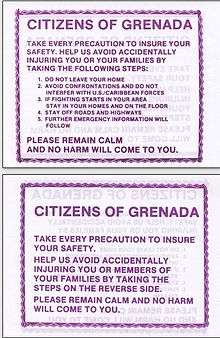
Time magazine described the invasion as having "broad popular support." A congressional study group concluded that the invasion had been justified, as most members felt that American students at the university near a contested runway could have been taken hostage as American diplomats in Iran had been four years previously. The group's report caused House Speaker Tip O'Neill to change his position on the issue from opposition to support.[16]

However, some members of the study group dissented from its findings. Congressman Louis Stokes (D, Ohio) stated: "Not a single American child nor single American national was in any way placed in danger or placed in a hostage situation prior to the invasion." The Congressional Black Caucus denounced the invasion, and seven Democratic congressmen introduced an unsuccessful resolution to impeach President Reagan, led by Ted Weiss.[16]
Medical students in Grenada speaking to Ted Koppel on 25 October 1983 edition of his newscast Nightline stated that they were safe and did not feel that their lives were in danger. Medical students told Koppel the next evening how grateful they were for the invasion and the Army Rangers, which probably saved their lives. State Department officials had assured the medical students that they would be able to complete their medical school education in the United States.[59][60]
International reaction
The United Nations General Assembly adopted General Assembly Resolution 38/7 on 2 November 1983 by a vote of 108 to 9 which "deeply deplores the armed intervention in Grenada, which constitutes a flagrant violation of international law and of the independence, sovereignty and territorial integrity of that State."[15] It went on to deplore "the death of innocent civilians" and the "killing of the Prime Minister and other prominent Grenadians", and it called for an "immediate cessation of the armed intervention" and demanded, "that free elections be organized".
This was the first military restoration of a Communist nation to its former governance. The Soviet Union said that Grenada had been the object of United States threats, that the invasion violated international law, and that no small nation would find itself safe if the aggression were not rebuffed. The governments of some countries stated that the United States intervention was a return to the era of barbarism. The governments of other countries said the United States had violated several treaties and conventions to which it was a party.[61] A similar resolution was discussed in the United Nations Security Council but it was ultimately vetoed by the United States.[57][62][58]
President Ronald Reagan was asked if he was concerned by the lopsided 108–9 vote in the UN General Assembly. He said, "it didn't upset my breakfast at all."[63]
Grenada is part of the Commonwealth of Nations, and it requested help from other Commonwealth members. The intervention was opposed by Commonwealth members including the United Kingdom, Trinidad and Tobago, and Canada.[3]:50 British Prime Minister Margaret Thatcher, a close ally of Reagan on other matters, personally opposed it. Reagan told her that it might happen; she did not know for sure that it was coming until three hours before. At 12:30 on the morning of the invasion, Thatcher sent a message to Reagan:
This action will be seen as intervention by a Western country in the internal affairs of a small independent nation, however unattractive its regime. I ask you to consider this in the context of our wider East/West relations and of the fact that we will be having in the next few days to present to our Parliament and people the siting of Cruise missiles in this country. I must ask you to think most carefully about these points. I cannot conceal that I am deeply disturbed by your latest communication. You asked for my advice. I have set it out and hope that even at this late stage you will take it into account before events are irrevocable.[64][65] (The full text remains classified.)
Reagan told Thatcher before anyone else that the invasion would begin in a few hours, but ignored her complaints. She publicly supported the action. Reagan phoned to apologize for the miscommunication, and the long-term friendly relationship endured.[66][67]
Aftermath

The American and Caribbean governments quickly reaffirmed Scoon as Queen Elizabeth's sole legitimate representative in Grenada, and hence the only lawful authority on the island. In accordance with Commonwealth constitutional practice, Scoon assumed power as interim head of government and formed an advisory council which named Nicholas Brathwaite as chairman pending new elections.[26][27] The Grenada National Party won the elections in December 1984 and formed a government led by Prime Minister Herbert Blaize.
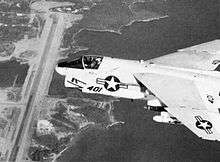
American forces remained in Grenada after combat operations finished in December as part of Operation Island Breeze. Elements remaining performed security missions and assisted members of the Caribbean Peacekeeping Force and the Royal Grenadian Police Force, including military police, special forces, and a specialized intelligence detachment. The Point Salines International Airport was renamed in honor of Prime Minister Maurice Bishop on 29 May 2009, his 65th birthday.[24][25] Hundreds of Grenadians turned out to commemorate the event. Prime Minister Tillman Thomas gave the keynote speech and referred to the renaming as an act of the Grenadian people coming home to themselves.[68] He also hoped that it would help bring closure to a chapter of denial in Grenada's history.
United States
The invasion showed problems with the American "information apparatus," which Time magazine described as still being in "some disarray" three weeks after the invasion. For example, the State Department falsely claimed that a mass grave had been discovered which held 100 bodies of islanders who had been killed by communist forces.[16] Major General Norman Schwarzkopf, deputy commander of the invasion force, said that 160 Grenadian soldiers and 71 Cubans had been killed during the invasion; the Pentagon had given a count of 59 Cuban and Grenadian deaths.[16] Ronald H. Cole's report for the Joint Chiefs of Staff showed an even lower count.[3]
Also of concern were the problems that the invasion showed with the military. There was a lack of intelligence about Grenada which exacerbated the difficulties faced by the quickly assembled invasion force. For example, they did not know that the students were actually at two different campuses, and there was a 30-hour delay in reaching students at the second campus.[16] Maps provided to soldiers on the ground were tourist maps on which military grid reference lines were drawn by hand to report locations of units and request artillery and aircraft fire support. They also did not show topography and were not marked with crucial positions. Navy ships providing naval gunfire and Marine, Air Force, and Navy fighter-bomber support aircraft providing close air support mistakenly killed American ground forces due to differences in charts and location coordinates, data, and methods of calling for fire support. Communications between services were also not compatible and hindered the coordination of operations. The landing strip was drawn by hand on the map given to some members of the invasion force.[69]
Reagan attempted to use the invasion of Grenada to end Vietnam Syndrome, a term used in reference to the American public's aversion to overseas conflicts that resulted from the Vietnam War.[70][71][72] After the invasion, on 13 December 1983, Reagan asserted that "our days of weakness are over. Our military forces are back on their feet and standing tall."[73]
Goldwater-Nichols Act
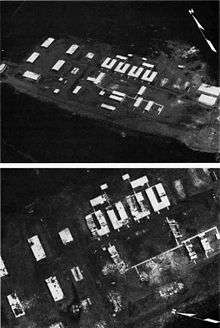
The Department of Defense recognized a need for improved communications and coordination among the branches of the American military. Congress investigated many of the problems and passed the Goldwater-Nichols Act of 1986 (Pub. L.99–433).[19] This act reworked the command structure of the military, making the most sweeping changes to the Department of Defense since the department was established in the National Security Act of 1947. It increased the power of the Chairman of the Joint Chiefs of Staff and advanced the concept of unified joint forces organized under one command.
Other

25 October is a national holiday in Grenada, called Thanksgiving Day, to commemorate the invasion. St. George's University (SGU) built a monument on its True Blue campus to honor the American servicemen killed during the invasion, and marks the day with an annual memorial ceremony.
Order of battle

Vice Admiral Joseph Metcalf, III, COMSECONDFLT, became Commander of Joint Task Force 120 (CJTF 120) and commanded units from the Air Force, Army, Navy, Marine Corps, and Coast Guard from the MARG flagship USS Guam. Rear Admiral Richard E. Berry (COMCRUDESGRU Eight) (Commander Task Group 20) supported the task force on the aircraft carrier USS Independence. Commanding Officer USS Guam (Task Force 124) was assigned the mission of seizing Pearls Airport and the port of Grenville, and of neutralizing any opposing forces in the area.[74] Simultaneously, Army Rangers in Task Force 123 would secure points at the southern end of the island, including the airfield under construction near Point Salines. The 82d Airborne Division (Task Force 121) were designated to follow and assume the security at Point Salines once it was seized by Task Force 123. Task Group 20.5, a carrier battle group built around USS Independence, and Air Force elements would support the ground forces.[74]
Ground forces
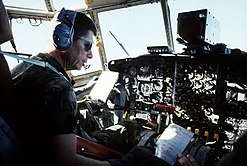
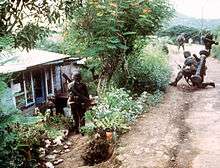

- 1st and 2nd Ranger Battalions 75th Ranger Regiment conducted a low-level parachute assault to secure Point Salines Airport. Hunter Army Airfield, GA and Ft. Lewis, WA
- 82nd Airborne Division – 2nd Brigade Task Force (325th Airborne Infantry Regiment plus supporting units) and 3rd Brigade Task Force (1st and 2nd Battalions of the 505th Parachute Infantry Regiment, 1st and 2nd Battalions of the 508th Parachute Infantry Regiment, plus supporting units) 82nd MP General Support Platoon HHC, 313th MI BN (CEWI). Fort Bragg, NC, 1st Battalion of the 319th Field Artillery.
- 27th Engineer Battalion of the 20th Engineer Brigade (Airborne), Fort Bragg, NC
- 548th Engineer Battalion Ft Bragg, NC
- 160th Aviation Battalion Ft Campbell, KY
- 18th Aviation Company, 269th Aviation Battalion Ft. Bragg, NC
- 1st and 2nd 82nd Combat Aviation Battalion, Fort Bragg N.C.
- 1 SQN 17 Air Cavalry Airborne, Fort Bragg N.C.
- 65th MP Company (Airborne), 118th MP Company (Airborne), and HHD, 503rd MP Battalion (Airborne) of the 16th Military Police Brigade (Airborne), XVIII Airborne Corps, Fort Bragg, NC
- 411th MP Company of the 89th Military Police Brigade, III Corps, Ft. Hood, Texas
- 35th Signal Brigade, Ft. Bragg, NC
- 50th Signal Battalion, 35th Signal Brigade, Ft. Bragg, NC
- 319th Military Intelligence Battalion and 519th Military Intelligence Battalion, 525th Military Intelligence Brigade, Fort Bragg, NC
- 9th Psychological Operations Battalion (Airborne) of the 4th Psychological Operations Group (Airborne) – provided loudspeaker support and dissemination of informational pamphlets. Fort Bragg, NC
- 1st Corps Support Command COSCOM, 7th Trans Battalion, 546th LMT Fort Bragg, NC
- 44th Medical Brigade – Personnel from the 44th Medical Brigade and operational units including the 5th MASH were deployed. Fort Bragg, NC
- 82nd Finance Company MPT
- 22nd Marine Amphibious Unit Camp Lejeune, NC
- US Navy SEAL Team 4 Little Creek, VA and US Navy SEAL Team 6 Virginia Beach, VA
- Air Force Detachment 1, 507th Tactical Air Control Wing (Fort Bragg, NC) – jump qualified TACPs who were attached to and deployed with the 82d Airborne, Fort Bragg, NC (now the 14th ASOS, part of the 18th Air Support Operations Group)
- 21st Tactical Air Support Squadron (Shaw AFB, SC). Jump qualified FACs who were attached to and deployed with Detachment 1, 507th Tactical Air Control Wing and the 82d Airborne, Fort Bragg, NC
- 5th Weather Squadron, 5th Weather Wing (MAC) Fort Bragg, NC. Jump qualified combat weathermen who are attached and deployed with the 82nd, now in AFSOC
- Det 1 MACOS Combat Controllers[75]
Air Force
- 136th Tactical Airlift Wing, Texas Air National Guard – provided C-130 Hercules combat airlift support, cargo, and supplies
- Various Air National Guard tactical fighter wings and squadrons – provided A-7D Corsair II ground-attack aircraft for close air support
- 23rd Tactical Fighter Wing – provided close air support for allied forces with A-10 Warthogs
- 26th Air Defense Squadron NORAD – provided air support for F-15 Eagles
- 33rd Tactical Fighter Wing – provided air superiority cover for allied forces with F-15 Eagles
- 437th Military Airlift Wing – provided airlift support with C-141 Starlifters
- 16th Special Operations Wing – flew AC-130H Spectre gunships
- 317th Military Airlift Wing – provided airlift support with C-130 Hercules from Pope AFB / Fort Bragg, NC complex to Grenada
- 63d Military Airlift Wing – Provided airlift support with C-141 Starlifter aircraft in the air landing of Airborne troops, 63rd Security Police Squadron provided airfield security support – (Norton AFB CA)
- 443rd Military Airlift Wing, 443rd Security Police Squadron (Altus AFB, OK) – provided a 44-man Airbase Ground Defense flight (Oct–Nov 1983)
- 19th Air Refueling Wing – provided aerial refueling support for all other aircraft
- 507th Tactical Air Control Wing (elements of the 21st TASS at Shaw AFB, SC and Detachment 1, Fort Bragg, NC) – provided Tactical Air Control Parties (TACPs) in support of the 82nd Airborne Division
- 552nd Air Control Wing, providing air control support with E-3 Sentry AWACS aircraft
- 62nd Security Police Group (Provisional) Multi Squadron Law Enforcement & Security Forces – Prisoner detaining and transport attached to 82nd Airborne
- 60th Military Airlift Wing's 60th Security Police Squadron (Travis AFB, CA) provided airfield security in Grenada as well as Barbados. 602nd OMS provided aircraft recovery teams for cargo operations.
Navy
Two formations of U.S. warships took part in the invasion. USS Independence carrier battle group; and Marine Amphibious Readiness Group, flagship USS Guam, USS Barnstable County, USS Manitowoc, USS Fort Snelling, and USS Trenton. Carrier Group Four was allocated the designation Task Group 20.5 for the operation.
| Surface warships | Carrier Air Wing Six (CVW-6) squadrons embarked aboard flagship Independence | |
|---|---|---|
| USS Independence | Fighter Squadron 14 (VF-14): 13 F-14A | Carrier Airborne Early Warning Squadron 122 (VAW-122): 4 E-2C |
| USS Coontz | Fighter Squadron 32 (VF-32): 14 F-14A | Electronic Attack Squadron 131 (VAQ-131): 4 EA-6B |
| USS Moosbrugger | Attack Squadron 176 (VA-176): 16 A-6E/KA-6D | Helicopter Antisubmarine Squadron (15 HS-15): 6 SH-3H |
| USS Caron | Attack Squadron 87 (VA-87): 12 A-7E | Sea Control Squadron 28 (VS-28): 10 S-3A |
| USS Clifton Sprague | Attack Squadron 15 (VA-15): 12 A-7E | COD: 1 C-1A |
| USS Suribachi | ---- | ---- |
In addition, the following ships supported naval operations:
USS Kidd, USS Aquila, USS Aubrey Fitch, USS Briscoe, USS Portsmouth, USS Recovery, USS Saipan, USS Sampson, USS Samuel Eliot Morison, USS John L. Hall, USS Silversides, USS Taurus, USNS Neosho, USS Caloosahatchee, USS Richmond K. Turner and USS Edson.
See also
- United States involvement in regime change
- Foreign interventions by the United States
- Heartbreak Ridge - a 1986 Clint Eastwood movie about the invasion.
Notes
- Clarke, Jeffrey J. Operation Urgent Fury: Invasion of Grenada, October (PDF). United States Army.
- "Operation Urgent Fury", GlobalSecurity.org
- Cole, Ronald (1997). "Operation Urgent Fury: The Planning and Execution of Joint Operations in Grenada" (PDF). Archived from the original (PDF) on 16 November 2011. Retrieved 9 November 2006.
- "Medals Outnumber G.I.'s in Grenada Assault". The New York Times. 30 March 1984.
- Clodfelter, Micheal (2017). Warfare and Armed Conflicts: A Statistical Encyclopedia of Casualty and Other Figures, 1492–2015 (4th ed.). McFarland. p. 645. ISBN 978-0786474707.
- "Study Faults U.S. Military Tactics in Grenada Invasion"
- "The Invasion of Grenada". PBS.org.
- Russell, Lee; Mendez, Albert (2012). Grenada 1983. London: Osprey Publishing. p. 45.
- "Soldiers During the Invasion of Grenada". CardCow Vintage Postcards.
- Kukielski, Phil (18 September 2013). "How Grenada reshaped the US military". The Boston Globe. Retrieved 25 April 2020.
- Seabury, Paul; McDougall, Walter A., eds. (1984). The Grenada Papers. San Francisco: Institute for Contemporary Studies. ISBN 0-917616-68-5. OCLC 11233840.
- Scoon, Sir Paul (2003). Survival for Service: My Experiences as Governor General of Grenada. Oxford: Macmillan Caribbean. pp. 136 and 145. ISBN 0-333-97064-0. OCLC 54489557.
- "Caribbean Islands – A Regional Security System". country-data.com.
- Moore, Charles (2016). Margaret Thatcher: At her Zenith. p. 130.
- "United Nations General Assembly resolution 38/7". United Nations. 2 November 1983. Retrieved 5 March 2016.
- Magnuson, Ed (21 November 1983). "Getting Back to Normal". Time.
- "Grenada Trying to Find Remains of Slain Marxist PM". Fox News. Associated Press. 20 November 2014 [8 June 2012]. Retrieved 30 July 2020.
- Steven F. Hayward (2009). The Age of Reagan: The Conservative Counterrevolution: 1980–1989. Crown Forum. ISBN 978-1-4000-5357-5.
- Kukielski, Philip (2019). The U.S. Invasion of Grenada: legacy of a flawed victory. Jefferson, North Carolina: McFarland & Company. pp. 213–214. ISBN 978-1-4766-7879-5. OCLC 1123182247.
- Burrowes, Reynold A. (1988). Revolution and rescue in Grenada : an account of the U.S.-Caribbean invasion. New York: Greenwood Press. ISBN 0-313-26066-4. OCLC 17943224.
- Payne, Anthony, 1952- (1984). Grenada : revolution and invasion. Sutton, Paul K., Thorndike, Tony. New York: St. Martin's Press. pp. 31. ISBN 0-312-35042-2. OCLC 10548141.CS1 maint: multiple names: authors list (link)
- Peter Collier, David Horowitz (January 1987). "Another "Low Dishonest Decade" on the Left". Commentary.
- Gailey, Phil; Warren Weaver Jr. (26 March 1983). "Grenada". New York Times. Retrieved 11 March 2008.
- "St. Vincent's Prime Minister to officiate at renaming of Grenada international airport". Caribbean Net News newspaper. 26 May 2009.
- "Bishop's Honour: Grenada airport renamed after ex-PM". Caribbean News Agency (CANA). 30 May 2009. Archived from the original on 12 June 2009.
- Sir Paul Scoon, G-G of Grenada, at 2:36 on YouTube
- Martin, Douglas (9 September 2013). "Paul Scoon, Who Invited Grenada Invaders, Dies at 78". The New York Times.
- Thatcher, Margaret (January 2011). The Downing Street Year. London: HarperCollins. p. 841. ISBN 9780062029102.
- "Paul Scoon; who had key role in invasion of Grenada, dies at 78 - the Boston Globe".
- Martin, Douglas (8 September 2013). "Paul Scoon, Who Invited Grenada Invaders, Dies at 78". The New York Times.
- "United Nations General Assembly resolution 38/7". United Nations. 2 November 1983. Archived from the original on 19 November 2000.
- "Assembly calls for cessation of "armed intervention" in Grenada". UN Chronicle. 1984. Archived from the original on 27 June 2007.
- Carter, Gercine (26 September 2010). "Ex-airport boss recalls Cubana crash". Nation Newspaper. Archived from the original on 24 January 2012. Retrieved 16 October 2011.
- Barbados Prime Minister Dies Of Heart Attack, By Tony Cozier, 12 March 1985, The Associated Press of the U.S.A.
- Kukielski, Phil (8 September 2013). "How Grenada reshaped the US military". The Boston Globe. Retrieved 25 April 2020.
- Huchthausen, Peter (2004). America's Splendid Little Wars: A Short History of U.S. Engagements from the Fall of Saigon to Baghdad. New York: Penguin. p. 69. ISBN 978-0-14-200465-4.
- Grenada 1983 by Lee E. Russell and M. Albert Mendez, 1985 Osprey Publishing Ltd., ISBN 0-85045-583-9 pp. 28–48.
- Dominguez, Jorge (1 January 1989). To Make a World Safe for Revolution: Cuba's Foreign Policy. Center for International Affairs. pp. 154–253. ISBN 978-0674893252.
- Domínguez, Jorge I. (1989). To Make a World Safe for Revolution: Cuba's Foreign Policy. Cambridge, Massachusetts: Harvard University Press. ISBN 0-674-89325-5. pp. 168–69
- Woodward, Bob (1987). Veil: The Secret Wars of the CIA 1981–1987. Simon & Schuster.
- Leckie, Robert (1998). The Wars of America. Castle Books.
- https://www.sandiegoreader.com/news/1990/oct/04/you-know-ken/
- Stuart, Richard W. (2008). Operation Urgent Fury: The Invasion of Grenada, October 1983 (PDF). U.S. Army.
- "Turning the Tide: Operation Urgent Fury". Combat Reform. Retrieved 6 April 2016.
- Kreisher, Otto. "Operation URGENT FURY – Grenada". Marine Corps Association & Foundation.
- "Caron (DD-970)". public2.nhhcaws.local. Retrieved 26 December 2019.
- Kukielski, Philip (2019). The U.S. Invasion of Grenada : legacy of a flawed victory. Jefferson, North Carolina: McFarland & Company. pp. 66–68. ISBN 978-1-4766-7879-5. OCLC 1123182247.
- Kreisher, Otto (October 2003). "Operation URGENT FURY – Grenada". Marine Corps Association and Foundation. Retrieved 28 April 2016.
- Fortitudine: Newsletter of the Marine Corps Historical Program, Volumes 15–18. Tommell, Anthony Wayne. History and Museums Division, U.S. Marine Corps, 1985.
- New York Times, 15 November 1983, U.S. Defending Grenada Action Before O.A.S.
- John M. Karas and Jerald M. Goodman, "The United States Action in Grenada: An Exercise in Real Politik", 16 U. Miami Inter-Am. L. Rev. 53 (1984),
- Robert J. Beck, July 2008, Max Planck Encyclopedia of Public International Law, accessed through Oxford Public International Law,
- Waters, Maurice (1986). "The Invasion of Grenada, 1983 and the Collapse of Legal Norms". Journal of Peace Research. 23 (3): 229–246. doi:10.1177/002234338602300303. JSTOR 423822.
- Abram Chayes, 15 November 1983, "Grenada Was Illegally Invaded"
- Zunes, Stephen (October 2003). "The U.S. Invasion of Grenada: A Twenty Year Retrospective". Foreign Policy in Focus. Cite journal requires
|journal=(help) - "United Nations Security Council vetoes". United Nations. 28 October 1983.
- Nightline – 25 Oct 1983 – ABC – TV news: Vanderbilt Television News Archive
- Television News Archive: Nightline
- United Nations Yearbook, Volume 37, 1983, Department of Public Information, United Nations, New York
- "Spartacus Educational". Archived from the original on 29 June 2008.
- "Reagan: Vote loss in U.N. 'didn't upset my breakfast'". The Spokesman-Review. 4 November 1983. Retrieved 30 June 2013.
- "Thatcher letter to Reagan ("deeply disturbed" at U.S. plans) [memoirs extract]". Margaret Thatcher Foundation. 25 October 1983. Retrieved 25 October 2008.
- Thatcher, Margaret (1993) The Downing Street Years p. 331.
- John Campbell, Margaret Thatcher Volume Two: The Iron Lady (2011) pp. 273–79.
- Gary Williams, "'A Matter of Regret': Britain, the 1983 Grenada Crisis, and the Special Relationship." Twentieth Century British History 12#2 (2001): 208–30.
- "Prime Minister Speech at Airport Renaming Ceremony". Grenadian Connection. 30 May 2009.
- Kukielski, Philip (2019). The U.S. Invasion of Grenada : legacy of a flawed victory. Jefferson, North Carolina: McFarland & Company. p. 46. ISBN 978-1-4766-7879-5. OCLC 1123182247.
- Sandler, Norman D. (28 May 1984). "Reagan's view of Vietnam War unwavering". United Press International. Retrieved 22 January 2020.
Reagan, who blamed Congress for the outcome in Vietnam and in 1978 called the conflict 'a long, bloody war which our government refused to win,' contends his arms buildup, invasion of Grenada and dispatch of U.S. forces to world trouble spots signaled the end of 'the Vietnam Syndrome.'
- Beinart, Peter (7 June 2010). "Think Again: Ronald Reagan". Foreign Policy. Retrieved 22 January 2020.
His biographer Lou Cannon calls him “shameless” in using Grenada to revive America’s Vietnam-wounded pride.
- Chen, Edwin; Richter, Paul (2 March 1991). "U.S. Shakes Off Torment of Vietnam". Los Angeles Times. Retrieved 22 January 2020.
The Reagan Administration sought to shake off the Vietnam syndrome as it invaded Grenada in 1983 and bombed Libya in 1986.
- Clines, Francis X. (13 December 1983). "Military of U.S. 'Standing Tall,' Reagan Asserts". The New York Times. Retrieved 22 January 2020.
- Spector, Ronald (1987). "U.S. Marines in Grenada 1983" (PDF). p. 6.
- Naylor, Sean (2015). Relentless Strike, the Secret History of Joint Special Operations Command. St. Martin's Press. ISBN 978-1-250-01454-2.
Primary sources
- Grenada Documents, an Overview & Selection, DOD & State Dept, Sept 1984, 813 pages.
- Grenada, A Preliminary Report, DOD & State
- Joint Overview, Operation Urgent Fury, 1 May 1985, 87 pages
Further reading
- Adkin, Mark (1989). Urgent Fury: The Battle for Grenada: The Truth Behind the Largest U.S. Military Operation Since Vietnam. Lexington Books. ISBN 978-0-669-20717-0.
- Brands, H. W., Jr. (1987). "Decisions on American Armed Intervention: Lebanon, Dominican Republic, and Grenada". Political Science Quarterly. 102 (4): 607–624. doi:10.2307/2151304. JSTOR 2151304.
- Cole, Ronald H. (1997). Operation Urgent Fury: The Planning and Execution of Joint Operations in Grenada, 12 October - 2 November 1983 (PDF). Washington, D.C. Official Pentagon study.
- Gilmore, William C. (1984). The Grenada Intervention: Analysis and Documentation. New York: Facts on File. ISBN 978-0-87196-920-0.
- Moore, Charles. Margaret Thatcher: At her Zenith in London, Washington and Moscow (2016) pp. 117–35.
- Payne, Anthony. "The Grenada crisis in British politics." The Round Table 73.292 (1984): 403–410. online
- Russell, Lee (1985). Grenada 1983. London: Osprey. ISBN 978-0-85045-583-0., A military history.
- Williams, Gary. US-Grenada Relations: Revolution and Intervention in the Backyard (Macmillan, 2007).
External links
- Invasion of Grenada and Its Political Repercussions from the Dean Peter Krogh Foreign Affairs Digital Archives
- Operation: Urgent Fury, Grenada
- The 1983 Invasion of Grenada, Operation: Urgent Fury
- "Grenada, Operation Urgent Fury (23 October – 21 November 1983)"—Naval History & Heritage Command, U.S. Navy
- Grenada—a 1984 comic book about the invasion written by the CIA.

